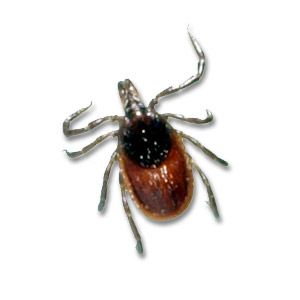
Blacklegged “Deer” Ticks
IXODES SCAPULARIS
Color: Orange-brown with dark legs
Shape: Flat, broad oval
Size: 1/8 inch long
Region: Found primarily in the northeastern, mid-Atlantic, southeastern, and north central regions of the U.S.
OVERVIEW
A notorious biting insect, the blacklegged tick is named for its dark legs, which are a contrast to its pale body. Blacklegged ticks are sometimes called deer ticks.
HABITS
Blacklegged deer ticks climb crass and shrubs to wait for a passing host. Adult ticks feed primarily on the white-tailed deer during the winter. In the spring, the female drops off the host and deposits about 3,000 eggs. Nymphs feed on mice, squirrels, raccoons, skunks, dogs, humans, and birds.
THREATS
Blacklegged deer ticks are a vector of Lyme disease, anaplasmosis, and babesoiosis. Lyme disease is of primary concern in the United States. Symptoms include fever, headache, fatigue, and a characteristic bull’s eye shaped skin rash. Lyme disease can also affect joints, the heart, and the nervous system if left untreated.
Check Out Our Promotions Today!
Want to see more reviews? Click Here!


